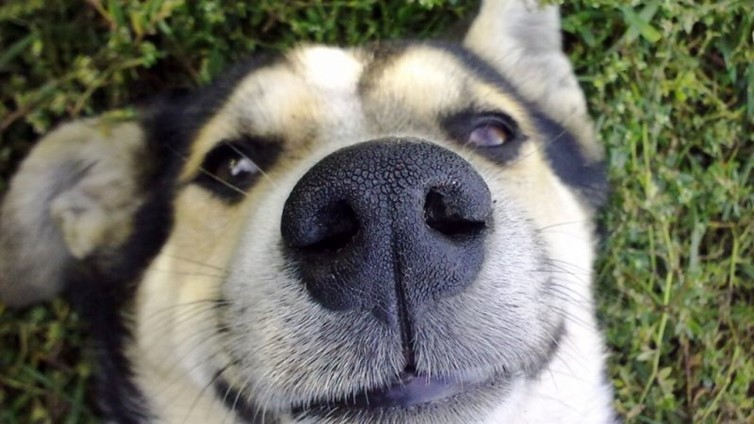For humans, the concept of smell is a bit intangible.
对人类来说,嗅觉的概念有些难以言说。
Sure our noses can identify milk that's gone bad or a batch of cookies fresh from the oven.
当然,我们的鼻子能分辨出变质的牛奶或是刚出炉的饼干。
The human nose can identify some 1 trillion smells, but it's just not that impressive compared to many members of the animal kingdom.
人类的鼻子能辨别出大约1万亿种气味,但与动物王国的许多成员相比,这并没有那么令人印象深刻。
Take the elephant, for example, that trunk isn't just for grabbing peanuts, it's sniffer is so powerful it can smell water from miles away.
以大象为例,它的鼻子不仅仅是用来抓花生的,它的嗅探器非常强大,可以闻到几英里外的水。
The trunks are also wildly multifunctional; as a straw, a dexterous limb, a vibration sensor, and of course, a trumpet.
象鼻也有许多种功能:如吸管、灵巧的肢体、振动传感器,当然还有喇叭。
Alright, you guys ready?
好了,你们准备好了吗?
Which kind of begs the question, what is a nose?
这就提出了一个问题,什么是鼻子?
This isn't technically a nose. It's more of a bony horn.
严格来说这不是鼻子,它更像是一个骨头突出的角。
This is a nose, but it's also a voice amplifier and somehow, a feature for attracting mates.
这是鼻子,但它也是一个扩音器,也是一个吸引伴侣的功能。
So by definition a nose just has to be a part of a face or facial region that contains nostrils and the organs of smell.
因此,根据定义,鼻子必须是面部或面部区域的一部分,包括鼻孔和嗅觉器官。
After that noses vary wildly in both aesthetics and function.
之后,鼻子在美学和功能上都有很大的不同。
Now I want to talk about a nose that is not only highly sensitive, but also has the impressive ability to remember smells over long periods of time.
现在我想说说这种鼻子,它不仅高度敏感,而且还具有很强的长时间记忆气味的能力。
They also might be the cutest... I'm talking about dogs.
它们也可能是最可爱的……我说的是小狗。

This is my dog Henry.
这是我的狗狗亨利。
I think he's a chihuahua toy fox terrier mix, but he loves treats.
我认为它是吉娃娃和狐狸玩具梗的串儿,它特别喜欢零食。
There you go.
给你。
But when I hold this treat up for him, Henry's not just smelling like "yep, that's a treat."
但当我拿着这个零食给亨利的时候,它可不单单是“嗯,这是个美味的零食”这么简单。
He's smelling in layers, so Henry's smelling the wheat flour, the chicken, the yeast that make up this treat, all separately.
它会一层层地闻,所以亨利闻到了小麦粉、鸡肉和酵母这些组成这个零食的所有味道,而且是分别闻出来的。
This is why dogs can detect illegally smuggled items buried in luggage and can even find people buried in avalanches.
这就是为什么小狗能发现埋在行李中的非法走私物品,甚至能找到埋在雪崩中的人。
So how does this work.
那么这是如何进行的呢。
Well, it all comes down to the structure of the nose and the sensory abilities of the brain.
嗯,这一切都归结为鼻子的结构和大脑的感官能力。
When Henry inhales his nostrils pull in air packed with molecules that contain smells.
当亨利吸气时,鼻孔吸入的空气中充满了含有气味的分子。
A fold of tissue just inside his nostrils separates the airflow into two paths, one for olfaction or smells, and the other one for respiration.
鼻孔内的一层组织将气流分成两条路径,一条用于嗅觉,另一条用于呼吸。
This prevents the dog from immediately breathing out to smell like we do.
这可以防止小狗像人类一样立刻呼出气体。
When they do exhale air exits through different slits in the sides of their nose.
当它们呼气时,空气会从鼻子的不同缝隙中排出。
This helps pull new odors into the nose through the nostrils and allows the dog to sniff practically continuously.
这有助于通过鼻孔将新的气味吸入鼻子,让小狗连续地闻味。
It also helps the dogs can identify which nostrils smell came through, so that they can locate which direction the smell is coming from.
这还可以帮助小狗识别气味是从哪个鼻孔传来的,这样它们就可以确定气味来自哪个方向。
Pretty helpful for early dogs that needed to hunt prey in the wild, or in Henry's case, finding the treats I've been hiding around the house.
这对那些早期需要在野外猎食的小狗很有帮助,或者对亨利来说,能找到我一直藏在家里的食物对它也很有帮助。
After inhalation and separation from the air going to the lungs, a small amount of air passes over turbinates.
在吸气、与进入肺部的空气分离后,少量空气会通过鼻甲。











